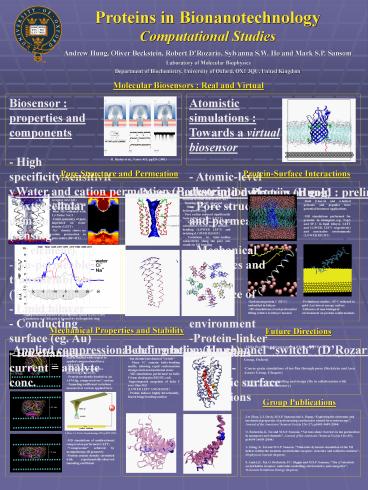Proteins in Bionanotechnology - PowerPoint PPT Presentation
1 / 1
Title:
Proteins in Bionanotechnology
Description:
Laboratory of Molecular Biophysics Department of Biochemistry, University of Oxford, OX1 3QU, United Kingdom ... and energetics , Molecular Membrane Biology ... – PowerPoint PPT presentation
Number of Views:58
Avg rating:3.0/5.0
Title: Proteins in Bionanotechnology
1
Proteins in Bionanotechnology Computational
Studies Andrew Hung, Oliver Beckstein, Robert
DRozario, Sylvanna S.W. Ho and Mark S.P. Sansom
Laboratory of Molecular Biophysics Department of
Biochemistry, University of Oxford, OX1 3QU,
United Kingdom
Molecular Biosensors Real and Virtual
- Biosensor properties and components
- - High specificity/sensitivity
- - Extracellular domain
- (sensing element)
- Ion-permeable transmembrane
- (TM) domain
- - Lipid bilayer
- - Conducting surface (eg. Au)
- - Ion channel current analyte conc.
- Atomistic simulations
- Towards a virtual biosensor
- - Atomic-level description of
- - Pore structure and permeation
- - Mechanical properties and stability
- Influence of solvent environment
- Protein-linker interactions
- -Protein-inorganic surface interactions
H. Bayley et al., Nature 413, pp226 (2001)
Pore Structure and Permeation
Protein-Surface Interactions
Water and cation permeation (Beckstein)
Pore structure and dynamics (Hung)
Protein on gold preliminary studies (Ho)
- - MD of unrestrained M2 in rigid scaffold of
outer helices (nAChR) - - Bending of 40-600 observed
- - Hinge point coincident with hydrophobic ring
- - Pore radius reduced significantly from initial
structure (LEFT) - - Anisotropic Network Model calculation reveals
major motions bending (LOWER LEFT) and twisting
(LOWER RIGHT) - - Variations in inter-residue connectivity along
the pore axis results in M2 bending
- -Nicotinic acetylcholine receptor (nAChR)
- Pore-lining M2 helices backbone-restrained
- 60ns MD collected with 1.3 Molar NaCl
- 5-fold symmetry of pore imprinted on water
density (LEFT) - Na density shows no cation permeation to pore
centre (RIGHT)
- Both ?-barrel and ?-helical proteins and peptides
have potential biosensor applications - MD simulations performed for proteins in
biological (eg. NspA and SP-C in lipid bilayer,
LEFT and LOWER LEFT respectively) and non-native
environments (LOWER RIGHT)
- Surfactant protein C (SP-C) embedded in bilayer
- MD simulations reveal preferential tilting
relative to bilayer normal
- Preliminary studies SP-C tethered to gold (Au)
lowest energy surface - Influence of non-biological environment on
protein conformations
- Potential of mean force shows free energy
required to place molecule/ion at specific
regions along pore - High permeation barrier at hydrophobic girdle
(L251-V255) - -Conclusion nAChR gate is formed by hydrophobic
ring
Mechanical Properties and Stability
Future Directions
Applied compressional deformation (Hung)
Bending helix ion channel switch (DRozario)
- Helix flexibility and pore gating (Hung and
DRozario) - ?-haemolysin/cyclodextrin simulations (Beckstein
and Hagan Bayley Group, Oxford) - Coarse-grain simulations of ion flux through
pores (Beckstein and Asen Asenov Group, Glasgow) - In silico biosensor modelling and design (Ho in
collaboration with National Physical Laboratory)
- Electron conductance of Cu azurin studied with
respect to applied compressional force
(BELOW) -Conductance-atomic force microscopy
(C-AFM) - Protein covalently bonded to Au AFM
tip, compressed on C surface - Tunneling
coefficient variations measured at various
applied force
- - Ion channel mechanical "switch"
- - Many IC contain helix-bending motifs, allowing
rapid conformation changes between functional
states - - MD simulations performed on helix F from
rhodopsin (RIGHT, red) - Superimposed snapshots of helix F over 10ns MD
- (LOWER LEFT AND RIGHT)
- - Proline induces highly directionally-biased
hinge bending motion
Group Publications
J-w Zhao, J.J. Davis, M.S.P. Sansom and A. Hung,
Exploring the electronic and mechanical
properties of protein using conductance atomif
force microscopy, Journal of the American
Chemical Society 126 (17), p5601-5609 (2004) O.
Beckstein, K. Tai and M.S.P. Sansom, Not ions
alone barriers to ion permeation in nanopores
and channels, Journal of the American Chemical
Society 126 (45), p14694-14695 (2004) A. Hung,
K. Tai and M.S.P. Sansom, Molecular dynamics
simulation of the M2 helices within the nicotinic
acetylcholine receptor structure and collective
motions, Biophysical Journal (in press) S.
Amiri, K. Tai, O. Beckstein, P.C. Biggin and
M.S.P. Sansom, The ?7 nicotinic acetylcholine
receptor molecular modelling, electrostatics,
and energetics, Molecular Membrane Biology (in
press)
J. Zhao, J. J. Davis, Nanotechnology 14(9), p1023
(2003)
- MD simulations of unidirectional compression
performed (LEFT) - Compression achieved by manipulating cell
geometry - Protein atomic density correlated with
experimentally-observed tunneling coefficient

